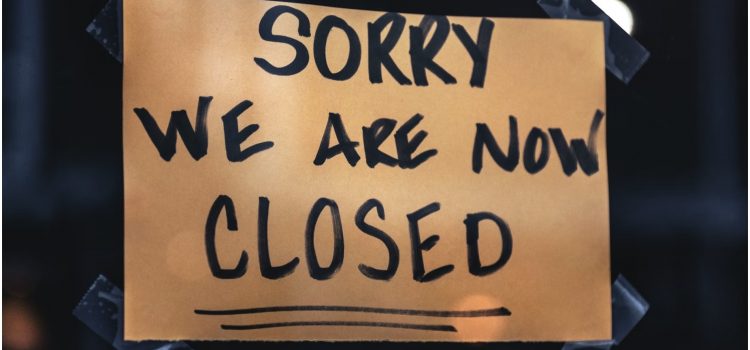
What are the five stages of business failure? How fast does it take for a business to fall apart?
In How the Mighty Fall, Jim Collins analyzes why well-performing companies end up failing. He states that there are five phases businesses go through during decline: overconfidence, overreaching, ignoring the signs, overcorrecting, and surrendering.
Let’s look at these five stages of failure businesses experience if leaders don’t find solutions.
The Five Phases Leading to a Company’s Downfall
Collins analyzes companies’ performance through the lens of failure rather than success, arguing that understanding failure helps companies avoid it. To determine the causes of decline, he takes pairs of companies in the same industry, analyzes what the failed companies did differently from the successful ones, and determines what the failed companies had in common.
(Shortform note: Collins employs the opposite method in his other books, such as Built to Last and Good to Great—in those books, while he also takes pairs of companies in the same industry and compares them, he instead maps out what the successful companies have in common. Some argue that learning from success is more effective than learning from failure—in Rework, Jason Fried and David Heinemeier Hansson write that understanding failure only shows what we shouldn’t do, not what we should.)
Collins writes that companies don’t fail overnight. Instead, they decline gradually in a process involving five stages of failure, which are also the reasons why businesses fail:
- Phase 1: Overconfidence
- Phase 2: Overreaching
- Phase 3: Ignoring—or misreading—the signs
- Phase 4: Overcorrecting
- Phase 5: Surrendering
Collins acknowledges that his work shows correlation, not causation—he can only infer why companies failed based on their similarities. He adds that while the five phases are typical in the case studies he reviewed, companies that deteriorate don’t necessarily undergo all phases, nor do they have to go through them in order. Still, companies should be aware of all the harbingers of failure to better guard against them.
(Shortform note: Aside from Collins’s five phases, some experts caution that there are other signs that a company is headed in the wrong direction: a lack of transparency, which breeds uncertainty and distrust within the company; a lack of cooperation, marked by disrespect, selfishness, and tribalism; and a bleak atmosphere, where people lack the drive to do good work.)
Here, we’ll describe each of Collins’s five phases in turn.
Stage 1: Overconfidence
The first phase of a company’s decline is overconfidence. When companies become successful, some fall into the trap of believing they can do no wrong and that success can only breed more success.
Overconfidence manifests in two ways: Either a successful company arrogantly goes full speed ahead with ill-advised projects, or it takes its focus away from its successful core business because it’s distracted by shiny, new pursuits.
Stage 2: Overreaching
According to Collins, the second phase leading to a company’s downfall is overreaching. This is when a successful company becomes obsessed with growth in all the wrong ways. Rather than pursuing steady, controlled growth in crucial areas like performance and people, the company falls into the trap of thinking that “bigger is better” and looks for ways to grow exponentially and rapidly—even if it means veering away from the company’s core purpose or chasing after growth it can’t sustain.
Collins cites Ames Department Stores as an example of an overreaching company. Ames had seen impressive growth over three decades as a small-town retailer. In a bid to break into the urban market and increase the company to twice its size, Ames acquired Zayre, another department store chain. However, Zayre’s business model and strategies didn’t align with Ames’s, and Ames quickly tried to pivot, moving away from the formula that had helped it succeed. The move led to the company’s downfall: Ames went out of business in 2002.
Stage 3: Ignoring—or Misreading—the Signs
The third phase of a company’s downfall is when it disregards signs of decline and makes reckless decisions with potentially disastrous consequences.
Companies generally don’t collapse overnight. Collins writes that there are warning signs when a company is deteriorating, such as fewer customers and lower profits. However, instead of facing problems head-on and pinpointing internal causes of decline, leaders might respond by blaming outside factors like an economic slump, or by choosing to interpret inconclusive data with an overly optimistic eye.
Turning a blind eye to the subtle markers of trouble, a company’s leaders might then take big risks—ones that could have catastrophic consequences for the company if they don’t pay off. Collins again cites the example of Motorola, which started developing Iridium, a satellite phone, before cellular phones exploded onto the scene. The arrival of the cellphone should have given Motorola pause. The evidence was clear: Cellphones were sleeker, cheaper, and offered better coverage than satellite phones. But the company chose to believe that there was still a need for satellite phones and went full speed ahead, funneling $2 billion into the project. In the end, the all-or-nothing bet didn’t pay off, and Motorola filed for bankruptcy.
Aside from careless risk-taking, a company in denial might also undergo reorganization—sometimes multiple times—favoring cosmetic changes that don’t address the real issues over substantive action.
For example, Collins writes that Scott Paper Company, once the leader in the toilet paper market, restructured three times in four years as a response to Procter & Gamble (P&G) gaining ground with its own brand of toilet paper.
Stage 4: Overcorrecting
Whereas leaders can brush off problems or look at data through rose-colored glasses in the third phase, they eventually have to face reality when the situation gets noticeably worse. This is the fourth phase, writes Collins: Leaders can no longer deny that the company is in trouble, and they scramble for a quick way to stop the decline. Collins explains that this reaction is borne out of instinct—we make desperate moves when we’re fighting to survive.
Collins writes that in this phase, companies pin their hopes on a savior. This may come in the form of an outsider who’s brought in to fix things or an overhaul of the company’s approach to business.
Stage 5: Giving Up
Collins writes that drastic moves in the fourth phase can lead to improvements in the company’s performance, but any positive change is usually short-lived. Instead, the dramatic changes that the company implements often result in confusion and strained finances: As a company pivots its vision and strategy, employees no longer know what the company stands for. More significantly, as the company pours resources into initiatives that are likely to fail, it further weakens its financial position. Thus begins the fifth phase: giving up, either because the leaders believe it’s the best option or because the company has run out of resources to keep going.






